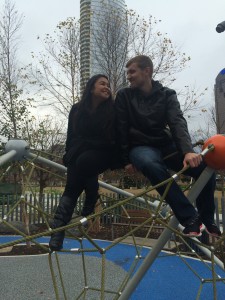More than 30 years ago, BYU graduate Melanie Hall said goodbye to her fiancé as he boarded a plane for Sweden, where he would live for the next three months. The couple communicated through handwritten letters and were reunited just days before their wedding.
Now in the 21st century, couples can communicate through social media, phone calls and applications like Skype. Here’s a look into how couples have made their long-distance relationships work — then and now.
Making it work: Then
An international engagement
BYU had just let out for the summer, and Hall, an elementary education major, flew to California to spend time with her fiancé and his sister. After their short visit, she returned home to Utah, and he boarded a plane to Sweden.
“An investigator from his mission offered to pay for his flight and to have him live with him while he got to work with a yogurt plant there in Sweden,” Hall said. “Since his career plan was to develop his own yogurt, this was a once-in-a-lifetime experience.”
Throughout the summer, the couple’s primary method of communication was mail.
“We wrote letters about once a week. They were four, five pages long,” Hall said. “I think we may have spoken once or twice, but it was very expensive to call between countries.”
At the end of the summer, the couple was married in the Salt Lake City Temple. Although the long-distance relationship was not ideal, the relationship picked right back up when Hall and her fiancé were together.
“When he got back, I remember thinking, ‘Who is this? Do I really know him?’ because it had been so long since we had been together,” Hall said. “The feelings went away, though. After a few days, it was like we had not been apart at all. “
Making it work: Now
A stateside engagement
In April 2013, Kiley Jones, a BYU senior majoring in elementary education, got engaged. Soon after the engagement, her fiancé left to do summer sales in Las Vegas while she worked in California. They were apart for more than three months, only seeing each other once a month. Fortunately, modern technology made it so they could still talk on the phone and even see each other through video calling.
“We went from spending every spare moment with each other to calling each other in our free time and Skyping each other at night. When you love someone you want to do everything with them and share experiences with them,” Jones said. “When you’re apart, you don’t get the chance to do that, and you have to settle for just telling each other what you did that day instead of actually doing the things together.”
They were reunited at the end of summer and married that August.

A university divide
College can be a hectic time of life to balance work, school, extracurricular activities, a social life and sometimes a relationship. It can become even more complicated when the two people in the relationship attend different schools.
Although distance from their partners hasn’t been a concern for some college students, many have been in long-distance situations. According to LDR Magazine, an online publication written for individuals in long-distance relationships, 70 percent of college students have been in a long-distance relationship.
Hope Abarintos and Tyler Grant, who started dating their senior year of high school, were part of the 70 percent. After graduating from high school, Abarintos went to study at the University of Houston and Grant attended the University of Texas at San Antonio. The schools are about three hours away from each other.
“Even though I was on a campus with 40,000 students, without him there, it truly felt empty,” Abarintos said.
During the more difficult times apart, the couple found Skype to be a great resource and found time to regularly call each other. Since the distance between the schools was relatively short, they also found many opportunities to visit each other during the school year. Although they enjoyed the time spent together, they found it hard to leave after each visit.
“The hardest part about being in a long-distance relationship was definitely having to leave when we got to see each other,” Grant said.
After a year at different schools, Grant decided to transfer to the University of Houston and is now studying kinesiology there. Abarintos and Grant have been dating for more than three years.
Dear Elder
At BYU, many relationships go long distance happen because of a partner’s decision to serve a full-time mission for the LDS Church. Tara Weise, a BYU student from Las Vegas majoring in photography, has been writing letters for more than a year to her boyfriend serving an LDS mission in Nicaragua.

Weise said the hardest part for her is not being able to effectively communicate. Although they are able to talk through letters and emails, she found that it is hard to really express herself without doing it in person. However, the two take advantage of the communication channels they do have and try to always be honest with each another.
“We talk every week about just the high points of that week, and we still ask each other’s advice on situations,” Weise said. “We don’t keep secrets from each other and still involve each other in our lives and in decisions that we make. It’s always a work in progress though.”
Making it work: A personal decision
Long-distance relationships have obviously changed over time with different technological developments. However, that’s not to say that long-distance relationships are easier on individuals today. Regardless of the time period or circumstance, it takes work. However, several couples have proven that it is not impossible.
Mike Goodman, an LDS marriage and family professor at BYU, believes there are both positive and negative aspects of long-distance relationships.
“When coming to know a person, it is extremely helpful to see them in a variety of circumstances and settings and to watch them interact not only with you but with other people,” he said. “These things are near impossible in long-distance relationships.”
However, when the couple has already had ample time to get to know each other before distance becomes a factor, the time apart could strengthen the foundation they’ve already built.
“Long-distance relationships somewhat force a couple to learn to talk, to really communicate, which can, in some cases, lead to a level of emotional intimacy which is deeper than some couples who are together constantly but which rarely get beyond the small-talk of day-to-day events,” Goodman said.
Regardless of the specific situation, long-distance relationships are a personal decision. For some, it may be feasible. Others may decide it’s not for them. However, as several couples have illustrated, there is a way to make it work.
“It can work if you really want it to work,” Jones said. “It’s terrible, and I would never want to do it again; but some people are worth waiting for.”




